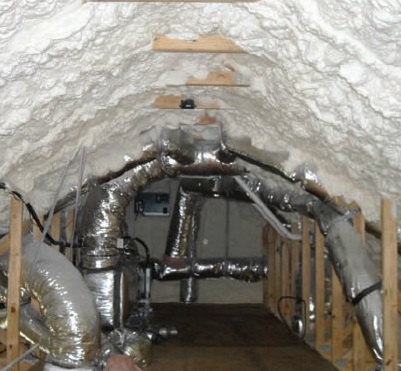Spray Foam Insulation In The Desert: 7 Facts You Need To Know
A spray foam insulation project in a hot and dry climate like Phoenix is much different than a spray foam insulation project in a cold or humid climate. The desert environment affects product selection, method of application, and the finished results.
1. Open Cell Spray Foam Insulation Dominates In Phoenix
Open cell and closed cell foam insulation are different variations of the same polyurethane product. If more than 50% of the cells are open, the foam is considered an open-cell foam. Conversely, if more than 50% of the cells are closed, the foam is labeled a closed-cell material.

Generally speaking, the higher the percentage of closed cells, the more dense the foam will be.
Open-cell foam is less expensive and less labor-intensive to install than closed-cell foam. Additionally, suppose there is enough room to install open-cell foam to sufficient depth. In that case, its performance is equivalent to closed-cell foam.
So, you might be thinking, if the open-cell foam is less expensive and performs the same – why does anyone use a closed-cell product?
Closed Cell Is For Condensation
In cold climates, when warm moist air meets a cold surface, moisture condensation occurs. If you have moisture condensation in your home and it does not dry quickly, it can lead to severe problems.
Closed-cell foam is so dense – that if condensation occurs – it will only happen on the surface of the material. When moisture is on the surface of your foam, it can evaporate quickly, preventing severe moisture problems.
However, in a dry climate, closed-cell foam is not necessary for moisture control.
If You Have Less Than 3″ Of Space, Use Closed Cell Foam
If you have less than 3″ of space – such as a furring strip on an old slump block wall – use closed-cell foam. It provides high impact performance at shallow depths.
2. If You Have More Than 3″ Of Space, Use Open Cell Foam
In real-world applications, the first inch of insulation does the most work. Each subsequent inch of depth does progressively less work.
For example, visualize that your foam insulation reduces heat flow by 50% per inch of depth. If ten heat units penetrate the first inch of foam, only five heat units penetrate the second inch. Since the second inch reduces heat flow by a further 50%, only 2.5 units of heat will penetrate the third inch of insulation.

As you can see, the deeper your insulation becomes, the less work it needs to do. Eventually, adding additional inches of depth has close to zero impact on energy efficiency.
3. Spray Foam Insulates AND Seals Air Leaks
So, by this point, you might be wondering, “Why not just install two inches of open-cell insulation and save some money?” The answer to that question is air seal.
If there is no air seal, heat will travel through the air – bypassing your insulation.
Closed-cell foam creates an airtight seal at one inch of depth. However, you need a minimum of two inches of open-cell foam to create an air seal.

Due to the irregular surface of open-cell foam, achieving an air seal requires 3″ of foam. Therefore, never install open-cell in areas where there are less than three inches of space.
4. Density Is More Important Than R-Value
What Is R-Value?
Walk into your local big box hardware store and look at the insulation. You’ll see the term R-Value prominently displayed on the package. Historically, R-Value was the only measurement of energy efficiency referenced in the building code.
The approach in the past – and unfortunately still today in many cases – was the more R-Value you have, the more energy-efficient you are. While this is true in a controlled laboratory setting, it’s not accurate in real-world applications where building and climate conditions vary continuously.
R-Value Measures One Of Three Methods Of Heat Flow
R-Value measures heat flow resistance through physical materials such as insulation, wood, etc. This type of heat flow is called conduction. However, there are two other ways for heat to flow: convection (drafts) and radiation (light).
R-Value does not account for heat flow through convection and radiation.
Convection: Heat flow through the air, i.e., drafts. Whenever there are two different air temperatures, there is an air pressure difference. Convection occurs when the air seeks to balance the pressure.
Radiation: Radiation is heat flow through light. Radiant heat exposure is critical for products like windows or roofing materials. However, it has little impact on insulation because there is very faint light where insulation is present.
Since radiant heat is an insignificant factor in insulation, your focus should be on conduction and convection. R-Value is a measurement of resistance to conduction heat flow, but how do you stop convection heat? The answer, air sealing.
Foam Density Blocks Convection Heat Flow
Since convection is heat flow through the air, the way to stop it is to create an air seal.
Unlike traditional fiberglass or cellulose insulation, spray foam insulates and air seals. The air sealing properties are the reason why foam insulation is such a great product.
However, the less dense a foam product is, the more depth of foam you need to create an air seal. Therefore, product density is critical when deciding what type of foam to install in your project.
5. Density Over Depth, But Density Costs More
The more dense the foam product, the more costly it will be for your project. Why? Because the more dense the product, the more foam you are getting per inch of depth!
So, always weigh density against cost and desired performance. Typically, the more depth you have available for insulation, the less dense the product needs to be to create an air seal. Therefore, you can save quite a bit of money without sacrificing performance if you have enough space.
6. The Ideal Spray Foam Insulation Density For Phoenix Is 0.5 Lb Ft3
Assuming you have three inches or more of space available, use 0.5 lb cubic foot density foam in a desert climate.
Avoid Builder Grade Foam
Due to the constant pressure to reduce costs in Arizona tract home construction, manufacturers make spray foam products at lower and lower densities.

But, lower densities equal less foam. When you install extremely low-density material, increase the depth to compensate for the lower density. However, if you add to the depth proportionately, it will wash out the savings.
When Is Builder Grade Foam The Best Option?
If your budget does not allow for a standard density product, go with the builder-grade product. Even the cheap stuff is many orders of magnitude better than fiberglass or cellulose.
7. Heat Can Ruin Your Foam Long Before Its In Your Home
Unlike all other construction products, contractors manufacture foam insulation on the job site. Manufacturers make the foam components, but your spray foam contractor makes the foam itself. Hence, to ensure a high-quality finished product, you should select a conscientious company for your project.
Foam Components Have A Short Shelf Life
Spray foam insulation components have a six-month shelf life. After six months, the catalyst in the product degrades, resulting in poor-quality, brittle foam. It will still insulate, but not to its full potential.
Arizona Heat Accelerates The Breakdown Of Foam Components
The ingredients for foam insulation have a six-month shelf life only if you store them at room temperature. If a company keeps the components on an asphalt parking lot or in a non-climate controlled space, the foam degrades quickly.
How Can You Tell If Your Foam Is Low Quality?
To the untrained eye, it’s impossible to tell if your foam is high or low-quality. However, one way to ensure you do not find yourself in this predicament is to hire a dependable spray foam contractor. The right contractor will make sure that they are installing good quality products from reputable manufacturers and distributors. Additionally, they’ll ensure that your foam is appropriately cared for throughout the supply chain before reaching your home.
How Do I Find A Good Contractor?
The most important metric for filtering out production-focused contractors from quality-focused contractors is asking how they compensate their employees.
Are their employees subcontractors? If so, do not hire them. Not only will you receive mediocre workmanship, but you’ll also expose yourself to liability risk if their subcontractors are uninsured. In the Phoenix area, uninsured insulation industry subcontractors are commonplace.
Do they pay their technicians by the hour or by the job/square feet? Technicians who are compensated by the square foot are intrinsically motivated to complete the work as quickly as possible. Which always means sacrificing quality wherever they can. However, it is rarely intentional on the technician’s part as most production-oriented companies train their technicians this way.
Best Insulation For Your Home
When installed correctly, nothing beats foam insulation. So, if you want your insulation to perform well and last for generations, do your homework ahead of time, hire a solid contractor, and reap the benefits for years to come.


